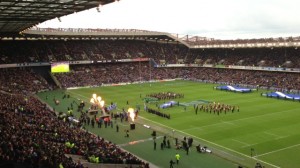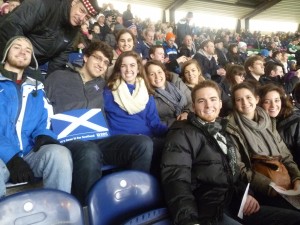Walking around the city of Edinburgh on Sunday February 24th, the streets were bustling with tension and excitement as Scottish and Irish rugby fans intermingled on the way to the much anticipated 6 Nations Rugby match. Everywhere you looked, fans decked in green or blue waited in line for buses and poured into pubs to get a good seat for the rivalry that was about to take place. Why was there so much excitement and what exactly is a 6 Nations Rugby match, you ask? Continue reading and learn for yourself as we take you along on our journey to Murrayfield Stadium where we watched two nations collide.
When we got off the bus at Murrayfield Stadium, the scene was one that let you know immediately this was going to be an exciting day of rugby watching, people watching, and most importantly, eating great stadium food (the burgers and curly fries were a hit!). Murrayfield Stadium, originally built in 1925 and most recently renovated in 1994, holds 67,130 fans and hosts all international rugby matches as well as football games and concerts. The name Murrayfield Stadium, which it was given due to area in which it stands, is well known to rugby fans and the people of Edinburgh alike. As we climbed the stairs to our seats in the upper deck, we noticed the interesting design of the outer edge of the stadium as well as the fact that the stadium was full to capacity.

While neither of us are huge rugby fans and know little about the sport, we had heard talk around the city that this match between Scotland and Ireland was one that always drew a rowdy crowd of loyal supporters. One of the reasons this match in particular was so popular was the fact that it was a part of the 6 Nations Rugby tournament. What nations make up this 6 Nations Rugby tournament, you say? The nations involved are Scotland, Ireland, England, Wales, Italy, and France. Annually, the countries face off in different match ups with a winner at the end of the tournament. Each country gets the opportunity to play every other country, with the advantage of playing on their home field switching every other year. How lucky we are to have been here for Scotland’s turn at playing at Murrayfield Stadium! Every year, a Championship Trophy is given to the team who successfully beats the most number of teams from the five other countries based on a points system. Currently Wales holds the trophy for winning the 2012 6 Nations tournament. Another interesting point is a different form of victory called the Triple Crown Trophy. Only Ireland, England, Scotland, and Wales are allowed to participate in this special competition. A country is awarded the Triple Crown Trophy if they are able to defeat all three of the other countries in the matches they play. Wales also currently holds the Triple Crown Trophy from defeating Scotland, Ireland, and England in 2012 (wow, they must have been eating their Wheaties!).

One other well-known award given is the Centenary Quaich, the trophy given annually to the winner of the Scotland v. Ireland match. While the blue and green teams have squared off in over 120 matches, this particular trophy has only been awarded since 1989. Good news for us, our temporary home, Scotland, has beat Ireland on more occasions, including this past Sunday in the 6 Nations tournament! Picture this, you are sitting in a stadium that much resembles a globe with its blue and green fans. Scotland has proudly sung their national anthem and Ireland has answered with their nation’s song. A small amount of points have been scored, and when they are, Ireland keeps the lead for some time (this was expected as Ireland was picked to win the match). Much to our surprise and to the surprise of our fellow fans present that day, Scotland made a come back that kept even us rugby amateurs on the edge of our seats.

It is safe to say that winning this match and joining in with fellow Scots as they jumped, cheered, and clapped, has been one of our proudest Scottish moments thus far! While it is always great when the unexpected team comes back for a win, it is even better when the team represents a country that has grown to mean so much to all of us. In true Scottish fashion, we also enjoyed heading out to a crowded pub after the match to celebrate the win. Now that you have been on the journey to victory with us, join in and cheer, Let’s Hear it for Scotland!

Remember to keep up with the blog for more adventures. We can’t wait to take you along on our next journey!
Essence and Arynn














